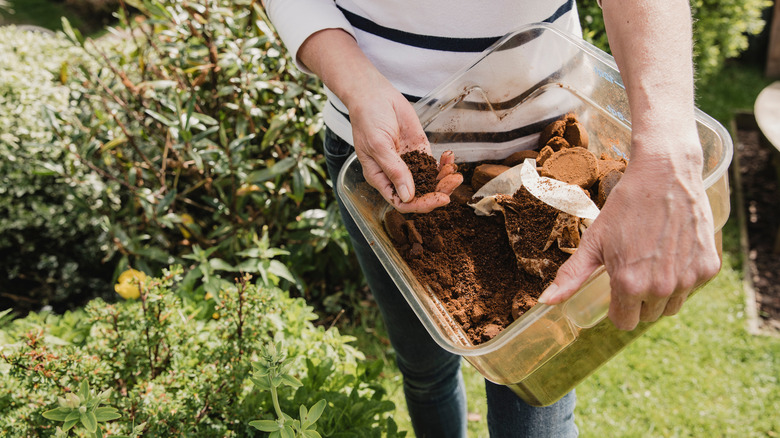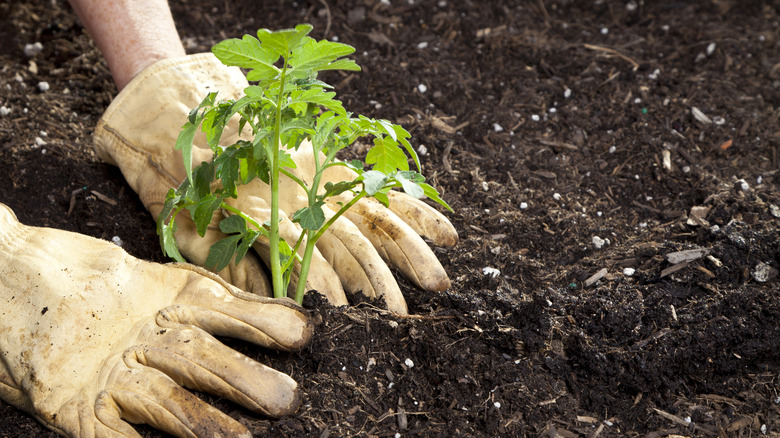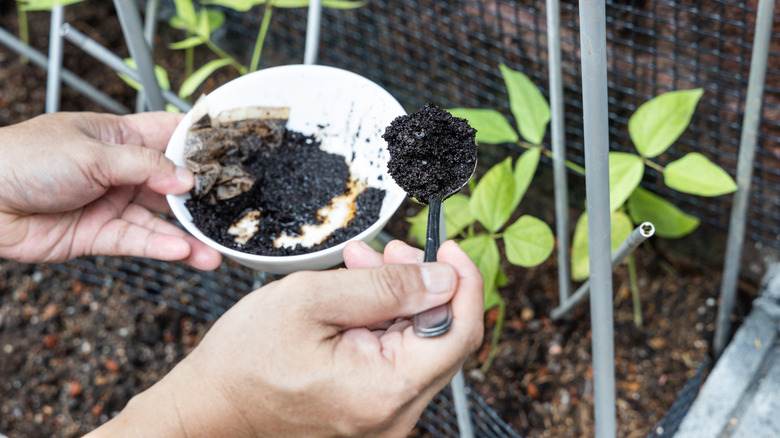Use Coffee Grounds To Give Tomato Plants A Boost
Google is chock full of information, good and bad. Some questions for which you might need garden answers include days to maturity, how much commercial fertilizer to use, or USDA hardiness zones — these are all inquiries for which there are specific numbers and scientific backing. I love absolutes. In contrast, there so many opinions with conflicting advice. If you search "Should I use coffee grounds on tomato plants?" you will likely get a frustrating number of different results. The simple answer is, yes: you can use the byproduct of your daily java in the soil or sprinkled on top to give your tomato plants a healthy boost. And, of course, composting is never a bad idea.
Differing opinions aren't limited to the internet. Gather 100 gardeners together and ask them what their favorite tomato variety is, and you might get 100 different answers. They could all have merit because there are so many delicious heirloom tomato varieties, and much of home gardening is based on specific conditions. In-bed gardens have different requirements than raised beds. Sandy soil requires a very different treatment from dense clay. And on it goes. In the case of coffee grounds, my experience using them with my tomatoes has been very positive, but be sure to avoid the rookie mistake of using unbrewed coffee grounds in the garden. The brewing process removes the acid that can harm plants.
Bury coffee grounds to create slow release fertilizer
When early spring rolls around, I like to start collecting some common items from the kitchen to create what I call my "tomato plant cocktail." I keep separate containers in my freezer with coffee grounds, banana peels, and ground up eggshells. Before I plant my tomatoes, I take these out to thaw, grab a bag of Epsom salts, and some compost. I dig an extra deep hole and toss in about a cup of coffee grounds, a few banana peels, a sprinkle of eggshells, 1 tablespoon of Epsom salts, and a handful or two of compost to the bottom. I top that with an inch or two of soil, and plant my tomato. Adding a layer of soil between the fertilizer and plant ensures the decomposing matter will not burn tender roots.
All of these ingredients provide a different nutrient, but you don't need all of them for your own tomato cocktail. You can just use what you have, or coffee grounds alone as a source of nitrogen and trace minerals. I like to add a coffee paper filter into the planting hole, since worms love paper products. This will attract them to the root area of your growing tomato plants. As they move through the soil, worms will leave their castings, an excellent source of nutrients for plants. As this organic matter decomposes, it helps improve the overall soil.
Add coffee grounds to the garden after planting tomatoes
If your plants are already in the ground, you can still add this kitchen waste product to the surface of the soil. This process offers the same benefits to tomato plants as it does by using coffee grounds to help hostas flourish. Not only will it slowly decompose, improving your soil quality and adding nutrients, but the strong scent may repel small mammals and insects. Simply sprinkle a thin layer of used coffee grounds around the base of each plant. Of course, if all of this sounds like too much work, you can always just toss your coffee grounds with the paper filter in your compost bin.
There is a situation in which you should avoid using coffee grounds in your soil. If your garden already has excessively high nitrogen levels, steer clear of any kind of fertilizer that has nitrogen, which includes used coffee grounds. Growing your best garden starts with balanced soil nutrients, so use a DIY testing kit or check with your local extension service to get a soil test for your most prolific tomato harvest.


